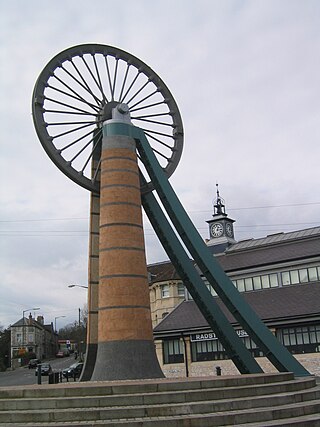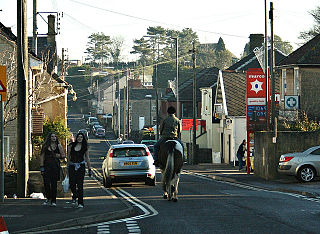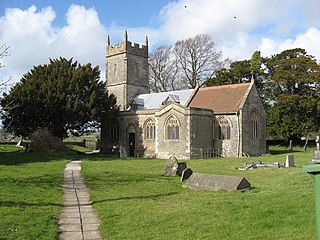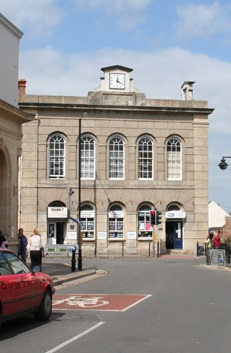
Bath and North East Somerset (B&NES) is a unitary authority district in England. Bath and North East Somerset Council was created on 1 April 1996 following the abolition of the county of Avon. It is part of the ceremonial county of Somerset.
Norton Radstock is the name of a former parish council that covered the conurbation of Midsomer Norton, Radstock and Westfield, in the English ceremonial county of Somerset. Created in 1974 as a large civil parish, it was abolished in 2011 and replaced by three smaller parishes.

Radstock is a town and civil parish on the northern slope of the Mendip Hills in Somerset, England, about 9 miles (14 km) south-west of Bath and 8 miles (13 km) north-west of Frome. It is within the area of the unitary authority of Bath and North East Somerset. The Radstock built-up area had a population of 9,419 at the 2011 Census.

Midsomer Norton is a town near the Mendip Hills in Bath and North East Somerset, England, 10 miles (16 km) south-west of Bath, 10 miles (16 km) north-east of Wells, 10 miles (16 km) north-west of Frome, 12 miles (19 km) west of Trowbridge and 16 miles (26 km) south-east of Bristol. It has a population of around 13,000. Along with Radstock and Westfield it used to be part of the conurbation and large civil parish of Norton Radstock, but is now a town council in its own right. It is also part of the unitary authority of Bath and North East Somerset.

Chilcompton is a village and civil parish in Somerset, England, situated in the Mendip Hills two miles south of Midsomer Norton and 3.0 miles south-west of Westfield. It is situated on the B3139 road between Radstock and Wells, close to the A37.

North East Somerset is a constituency represented in the House of Commons of the UK Parliament, since it was created for the 2010 general election, by Jacob Rees-Mogg of the Conservative Party.

Peasedown St John is a village and civil parish in Somerset, England, standing on a hilltop roughly 5 miles (8 km) south-southwest of the city of Bath, and 2 miles (3 km) north-east of the town of Radstock at the foot of the Mendip Hills. Peasedown used to be a coal mining village, and after the last of the mines shut in the 1970s it became a dormitory village for Bath, Trowbridge and to a lesser extent Bristol. Its size was increased by substantial housing developments in the 1960s, 1970s and late 1990s, making it one of the largest villages in Somerset.

Midsomer Norton railway station was a station on the Somerset and Dorset Joint Railway between Bath Green Park and Shepton Mallet. It served the town of Midsomer Norton in the English county of Somerset, which was also served by a second station known as Midsomer Norton and Welton railway station on the Bristol and North Somerset Railway.

Paulton Memorial Hospital is a community hospital located in the village of Paulton, Somerset, approximately 12 miles (19 km) from Bath, managed by Virgin Care.

Jacob William Rees-Mogg is a British politician serving as the Member of Parliament (MP) for North East Somerset since 2010. Now a backbencher, he served as Leader of the House of Commons and Lord President of the Council from 2019 to 2022, Minister of State for Brexit Opportunities and Government Efficiency from February to September 2022 and Secretary of State for Business, Energy and Industrial Strategy from September to October 2022. A member of the Conservative Party, Rees-Mogg previously chaired the eurosceptic European Research Group (ERG) from 2018 to 2019 and has been associated with socially conservative views.

Ston Easton is a linear village and civil parish in the English county of Somerset. It is 14 miles (23 km) southwest of Bath and 7 miles (11 km) north of Shepton Mallet. It forms part of the Mendip district and lies along the A37 road 11 miles (18 km) south of the cities of Bristol and Bath and to the west of the town of Midsomer Norton. The parish includes the hamlet of Clapton.

The Somerset Coalfield in northern Somerset, England is an area where coal was mined from the 15th century until 1973. It is part of a larger coalfield which stretched into southern Gloucestershire. The Somerset coalfield stretched from Cromhall in the north to the Mendip Hills in the south, and from Bath in the east to Nailsea in the west, a total area of about 240 square miles (622 km2). Most of the pits on the coalfield were concentrated in the Cam Brook, Wellow Brook and Nettlebridge Valleys and around Radstock and Farrington Gurney. The pits were grouped geographically, with clusters of pits close together working the same coal seams often under the same ownership. Many pits shared the trackways and tramways which connected them to the Somerset Coal Canal or railways for distribution.

Bath College is a further education college in the centre of Bath, Somerset and in Westfield, Somerset, England. It was formed in April 2015 by the merger of City of Bath College and Norton Radstock College. The College also offers Higher Education courses and has its own Undergraduate building.

Westfield is a settlement lying on the Fosse Way between Radstock and Midsomer Norton in Somerset, England. In 2011 it was raised to the status of a civil parish.
Colonel Sir Frank Beachim Beauchamp, 1st Baronet CBE was an industrialist who owned mines in the Somerset coalfield, notably in Midsomer Norton and Radstock. He was the first baronet of the Beauchamp Baronetcy of Woodborough, in the County of Somerset, created for him in 1918. He was also a Conservative county councillor for thirty-nine years.

Otley Civic Centre is a municipal structure in Cross Green, Otley, West Yorkshire, England. The structure, which was the offices and meeting place of Otley Town Council, is a Grade II listed building.

Wellington Town Hall is a municipal building in Fore Street, Wellington, Somerset, England. The structure, which was previously used as a civic events venue, is a Grade II listed building.

Minehead Town Hall is a municipal building in The Parade, Minehead, Somerset, England. The structure, which is the meeting place of Minehead Town Council, is a Grade II listed building.

Glastonbury Town Hall is a municipal building in Magdalene Street, Glastonbury, Somerset, England. The structure, which is the meeting place of Glastonbury Town Council, is a Grade II* listed building.

The Assembly Rooms in Presteigne, formerly Presteigne Town Hall, is a municipal building in Broad Street, Presteigne, Powys, Wales. The structure, which accommodates a public library on the ground floor and as an arts centre on the first floor, is a Grade II listed building.


















